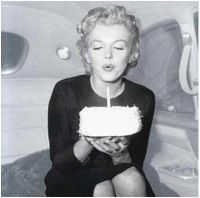Marilyn in the white dress over the subway vent. Marilyn singing a breathless happy birthday to JFK. Marilyn in hot pink full-length gloves, proclaiming that diamonds are a girl’s best friend.
Theses images of Marilyn Monroe have become iconic in their own right, and depictions of her have been reprised time and again in media, from movies (My Week with Marilyn) to music (her own verse in Elton John’s “Candle in the Wind”) to television (Megan Hilty, Katharine McPhee, and Uma Thurman have all played her on NBC’s Smash) to pop culture (see: the many fashions of Madonna and Lady Gaga).
Still, for a pop-cultural icon who has occupied the public’s imagination for the fifty-plus years following her death, Marilyn Monroe herself remains largely a mystery. Was she a talented actress overshadowed by her beauty? A sex goddess made famous only by her looks? A victim? A joke? A combination of them all?
For someone who remains, to this day, better known than most living movie stars, world leaders, and television personalities, perhaps the most surprising thing about Marilyn is that people have rarely taken her seriously enough to ask why this is so. Somewhere in the midst of all this fame, the woman herself has been lost.
Today, which would be her eighty-seventh birthday, seems like a good time to stop and ask: Just who was the real Marilyn Monroe?
It’s this real Marilyn who is the subject of two iconic biographies: Gloria Steinem’s Marilyn and Anthony Summers’s Goddess. It’s Marilyn like you’ve never seen her before.
Discover the Marilyn behind the myth.


